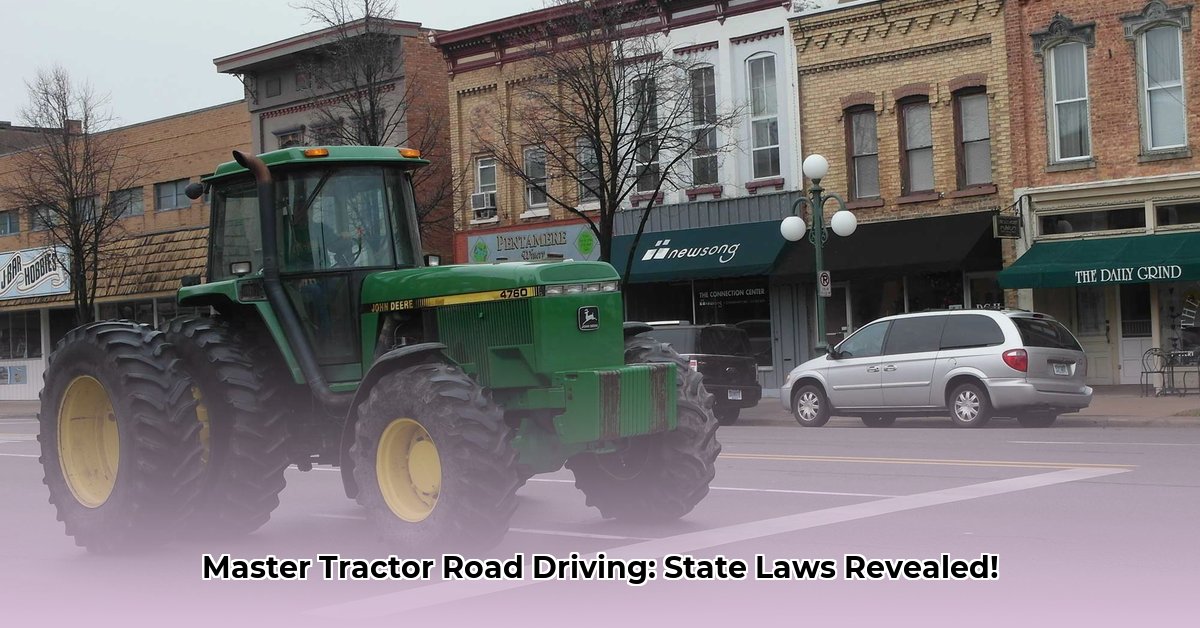
Understanding State-Specific Tractor Regulations: A Crucial First Step
Driving a tractor on public roads requires more than just knowing how to operate the machinery; it demands a thorough understanding of each state's unique regulations. Failure to comply can result in significant fines, legal repercussions, and, most importantly, serious accidents. This guide provides a comprehensive overview, helping you navigate the complexities of state-specific laws and best practices for safe tractor operation. Do you know the specific regulations in your state? Are you certain your insurance adequately covers you for all potential risks? For more detailed guidance, check out this helpful resource: Tractor Driving Guide. Let's explore these crucial aspects of safe tractor operation.
State-by-State Breakdown of Tractor Regulations
The following table provides a summary of key regulations. Remember: This information is for general guidance only. Always refer to your state's Department of Motor Vehicles (DMV) or Department of Agriculture website for the most current and accurate information. Laws change frequently; relying solely on this guide could lead to non-compliance.
| State | Lighting Requirements | Slow-Moving Vehicle (SMV) Emblem | Speed Limits (mph) | Operating Hours Restrictions | DMV/Agriculture Website |
|---|---|---|---|---|---|
| California | Headlights, taillights, turn signals required at night and in low visibility. Specific requirements vary by tractor size and type. | Required | Varies by road type; generally lower than cars. | Generally no specific restrictions, but night driving may require additional lighting. | California DMV |
| Texas | Headlights, taillights, and turn signals required for safe operation, especially at night or in low visibility. | Recommended | Varies by road type; generally lower than cars. | No specific time restrictions, but night driving is discouraged unless necessary. | Texas Department of Agriculture |
| Florida | Functional headlights, taillights, and turn signals are essential for safe operation in all conditions. | Required | Lower speeds than cars depending on road type and visibility. | No explicit operating hours; avoiding night driving is recommended. | Florida Department of Agriculture and Consumer Services |
| Iowa | Properly functioning lights required for safe operation, particularly at night or in low visibility. | Required | Lower speed limits than passenger vehicles with limits depending on road type. | Likely no set operating hours, but weather and light conditions must guide decisions. | Iowa Department of Transportation |
| Ohio | Adequate lighting is crucial, especially at night or in low visibility. Specific requirements may vary by tractor type. | Required | Speed limits are typically lower than for cars, and are determined by road conditions and type. | May have restrictions on driving during certain hours, especially in poor weather. | Ohio Department of Agriculture |
Note: The links provided above are examples and should be replaced with actual, working links to the relevant state agencies.
Best Practices for Safe Tractor Operation
Beyond adhering to legal requirements, proactive safety measures are crucial. These practices significantly reduce the risk of accidents.
Defensive Driving: Always anticipate the actions of other drivers. Assume they may not see you. Yield the right-of-way and exercise extreme caution at intersections.
Route Planning: Avoid rush hour traffic. Plan routes with wider shoulders and fewer intersections to simplify maneuvering and increase safety.
Regular Maintenance: Regular maintenance checks ensure your tractor’s lights, brakes, and tires are in optimal condition. This proactive approach helps prevent accidents before they happen. Aim for a full inspection before every road trip.
Enhanced Visibility: Use flashing lights and reflective tape to increase your visibility, especially at night or in inclement weather. Did you know that enhanced visibility significantly reduces the chance of collisions?
Comprehensive Insurance: Ensure you have adequate insurance coverage that accounts for potential damages and injuries. According to the National Agricultural Statistics Service, 92% of farmers with comprehensive insurance policies are better prepared for accidents.
Advocating for Safer Roads: Your Role in Change
Improving road safety requires collective effort. Here's how you can make a difference:
Driver Training: Support and promote comprehensive training programs for tractor operators. Improved training leads to safer driving practices.
Legislative Advocacy: Contact your state representatives to advocate for clearer, more consistent, and safer road regulations for farm vehicles. Your voice matters!
Conclusion: Prioritizing Safety on the Road
Operating a tractor on public roads requires a conscientious approach to both legal compliance and safety best practices. By understanding state-specific regulations, practicing defensive driving, and advocating for improved road safety, you contribute to a safer environment for all road users. Remember, every precaution taken is a step toward preventing accidents.